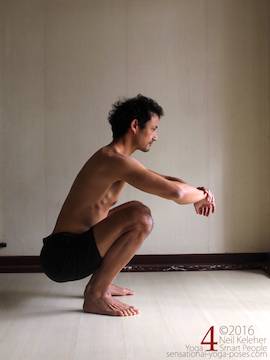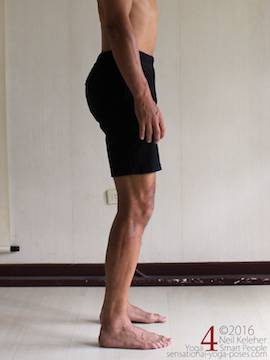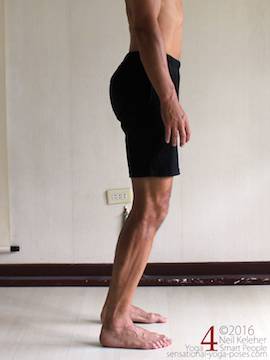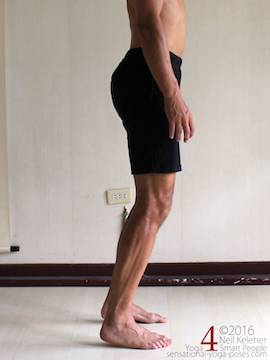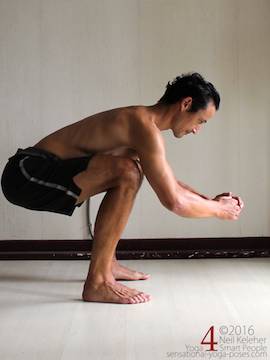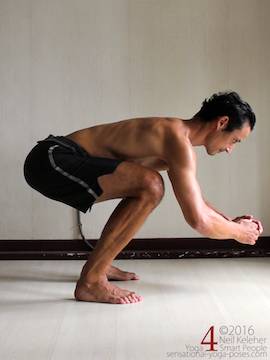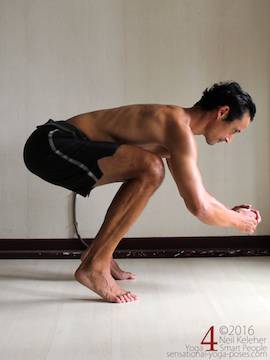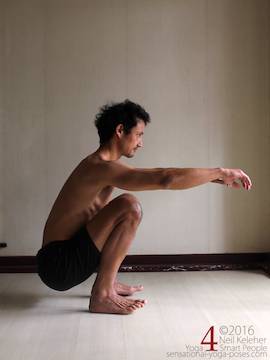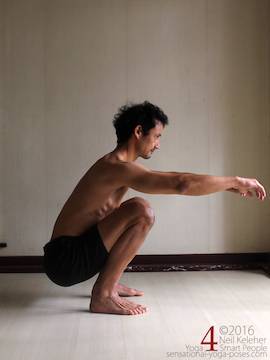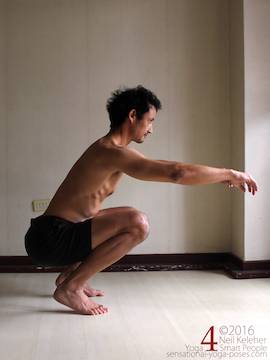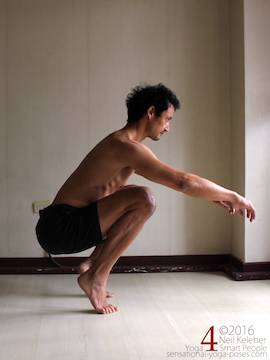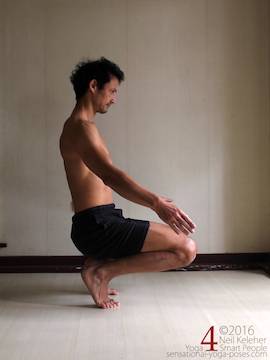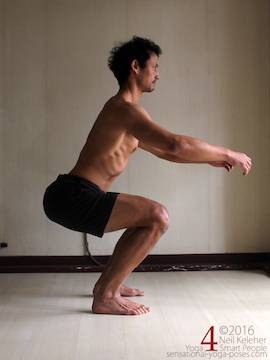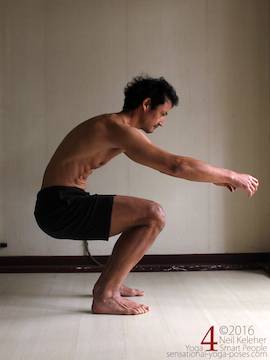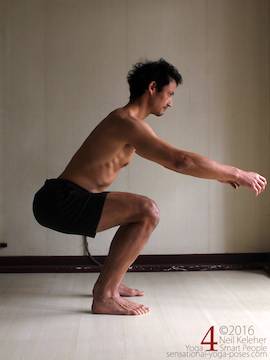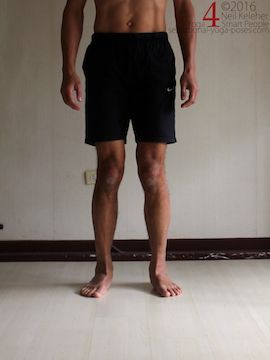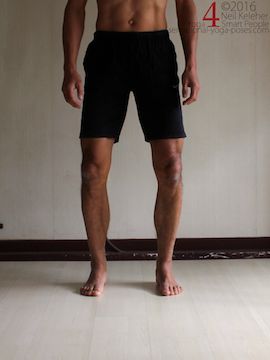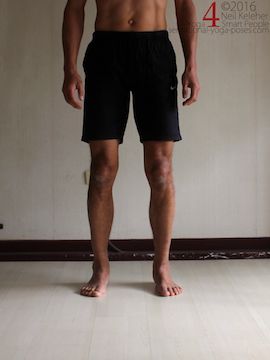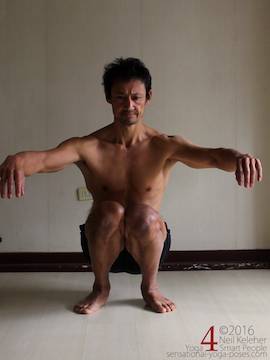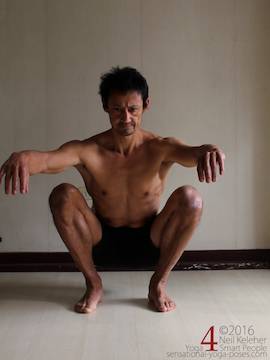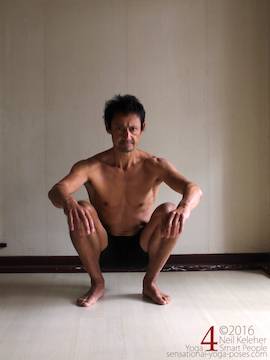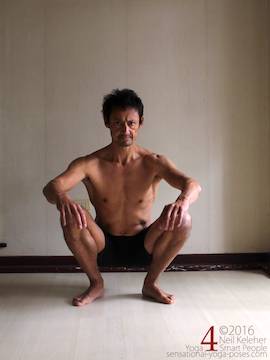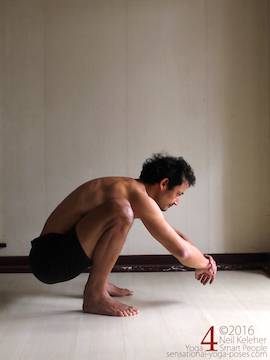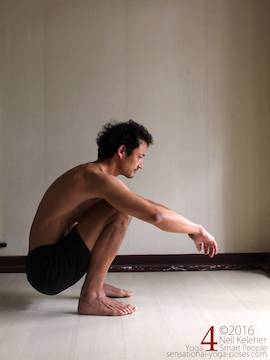Deep Squats
First learning to stay balanced
One problem that some people have when doing deep squats (or even doing thighs parallel to the ground squats like chair pose) is staying balanced. Some people tend to tip back as they go lower. How do you stay balanced while doing squats?
Another problem people have is sinking their hips all the way down or relaxing at the bottom of a deep squat. Some people experience hip and/or knee pain either during squats or after doing them. Is there a way to learn how to go all the way down, or to relax in at the bottom and to avoid these types of pain apart from not doing deep squats in the first place?
Related
Solving Problems with the Deep Squat
Yes it is easy to learn how to stay balanced. Slightly more difficult (but still possible) is learning how to operate your body while doing squats so that your knees and/or hips don't hurt. And as for going all the way down (and then relaxing if you choose), that can be a matter of practice. In all cases, how and what you practice can make a difference.
Staying Balanced While Doing Deep Squat
One of the simplest ways to learn to stay balanced while doing a deep squat is to practice shifting your weight forwards and backwards.
You can try it first while standing upright, then with thighs horizontal and then (if you can go that low) with your butt on your heels in a full "ass to the grass" squat.
Start with your weight back so that your heels press down. Then shift your weight forwards so that your feel your weight pressing down through forefoot and toes. From here you can lift your heels.
Basically, any time you fall back, it's probably because you are keeping your weight over your heels. So instead shift your weight forwards. You don't have to have your weight over your forefeet and toes. Instead try positioning your body so that your heels and forefeet press down with equal pressure. Keep the pressure even as you squat down (and stand back up).
Then you won't fall back.
Just for fun, if you keep your weight over your forefeet and toes you can try lifting your heels as high as possible then drop your knees so that your thighs and shins are almost horizontal, as in the second picture above.
One of the advantages of lifting the heels as high as possible is that it forces the muscles of the foot and ankle to be active. That can be good for your knees. If you can memorize the feeling of "active feet" in this position, use the same feeling to help keep your knees happy when doing regular squats (but while keeping your heels down. Another option is to squat while keeping the heels lifted. Yes your knees will go along way ahead of your toes but because the feet and ankles are active, this will help to keep your lower leg stable to that the muscles that cross the knees have a stable foundation from which to activate. That can help prevent your knees from being injured.
Controlling The Bend of Your Spine
In a Deep Squat
Some people worry about whether their spine should be straight or bent in various squat positions. I'd suggest that rather than worrying about which is the correct position, practice controlling your spine and feeling it. Then you can feel for yourself which is the best position at any point in time and in addition you practice mobilizing your spine.
These exercises, like the weight shifting exercise, can be done while standing first. Practice lifting your tailbone to roll your pelvis forwards and back bend your spine. Then drop your tailbone (or lift your pubic bone) to roll your pelvis backwards and flatten your spine. After practicing the basic action while standing, then try them in a "thighs horizontal" body weight squat position.
Another position that you can try to find both while standing with knees slightly bent and then in a thighs horizontal squat position it "opening the lower back". To find this position start with your pelvis tilted forwards. Then slowly tilt it back to the point that your lower back feels open or "full". It can feel quite comfortable. You could try moving up and down in a squat while maintaining this feeling in your lower back (and while staying balanced.) You could also try squatting while keeping your lumbar spine extended (bent backwards). In all cases move slowly and smoothly so that you can stop if anything feels uncomfortable. You can then easily make changes to remove the discomfort.
Controlling the Feel and Knees While Body Weight Squatting
Another exercise that you can practice while standing first and then while squatting deep is "rotating the shins" inwards and then outwards as in the pictures above.
- Rolling the shins inwards generally tends to collapse the arches of the feet. It also causes the knees to point inwards relative to the feet.
- Rolling the shins outward tends to lift the arches. If done excessively it points the knees outwards relative to the feet.
- In a "neutral" position the arches of the feet are nicely arched, not too much and not too little. And the knees point in the same direction as the feet.
Doing the same action while in the bottom position of a body weight squat will affect the alignment of the knees and feet and also whether the knees are in or out or somewhere in the middle.
Collapsing the arches by rolling the shins inwards can cause the knees to touch even if the feet are separated. Rolling the shins outwards can cause the knees to separate and that can be handy if you want to learn forwards between your knees. If you have knee pain while squatting this is one action that you can play with to see if it helps alleviate knee pain.
Adjusting Foot Position for the Body Weight Squat
Another option is to play with foot position, either making the feet wider apart or closer together (not shown) or by turning the feet out to various degrees. Here, assuming that shin rotation relative to the feet is kept constant, then the wider the feet are turned out the further apart the knees move.
Straight Spine or Bent (and Ankle Mobility)
If you are doing body weight squats as a preparation for weighted squats, it helps to practice keeping the spine as straight as possible. However, if you want to try and relax in the bottom position, you can experiment with keeping the spine straight or allowing it to bend forwards to see which is the more relaxing position.
Bending forwards between the knees it can be easier to stay balanced and easier to use your hands to do something while squatting. Notice also that in the first picture below my knees are not moving past my toes.
With spine straight, depending on the ratio of leg length to torso length you may find that your knees move forwards past the border of your toes. If you tilt your pelvis back to curve your spine, staying balanced on your heels as in the last picture below, you can also bring the knees back. It might not be the most comfortable squatting position but it is an option.
As you move up and down from a full squat position to standing and vice versa, if you find you are getting knee pain, play with shin rotation and the amount of arch in your foot. Also play with how far forwards or back your knees are. You may find that you have to balance on your heels to bring your knees back more, but if it makes your knees feel better then do it that way.
Playing with Pelvic (Sacroiliac Joint) Stability in the Body Weight Squat
Another option for hip and leg pain free body weight squatting is to play with pelvic stability. This isn't the same as hip stability (stabilizing the pelvis relative to the thigh). Instead it is the fixing of the pelvis so that it doesn't change shape. So I should say sacroiliac stability instead.
One basic actions can include pullings inwards on the ASIS the points at the front of each hip crest. This action activates the lower transverse abdominus. Another action is to pull the tailbone (the bottom tip of the sacrum) towards the pubic bone and then, while keeping that action, pulling inwards on the sitting bones. This helps to activate the pelvic floor muscles.
For possible obturator internus activation try spreading the sitting bones while keeping the thigh bones rotationally stable. So without allowing your thigh bones to rotate try spreading your sitting bones. You may find that your gluteus maximus/butt muscle automatically activates. Another option is to pull your sitting bones inwards. Here again you may find that your gluteus maximus activates, but in a slightly different way.
If you haven't read it already, you might find this article on the body weight squat also helpful.
Published: 2016 02 22
Updated: 2021 01 28
